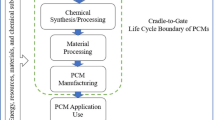Abstract
Alternative thermal energy storage (TES) materials are needed for the expected worldwide deployment of concentrated solar power (CSP) plants, and they should meet related criterion of technical, economical and ecological performances. This paper aims to quantify the environmental footprint of an alternative recycled ceramic made from industrial wastes by performing a comparative life cycle analysis. Compared to the conventional CSP TES technology based upon the two tank molten salt technique, the environmental impacts of the storage unit using recycled ceramics from industrial wastes are reduced by 40 % in terms of potential climate change, 30 % in primary energy demand and 60 % in water consumption. Those impacts are calculated for a scope of recycled ceramics promoting the use of secondary raw material and for which the inerting process is attached to the upstream lifecycle. If included, the energy payback time of the storage remains below 3 years before about 25–30 years of expected use. Such a low payback time represents a strong advantage toward further encouraging high added-value recovery, an issue which is often strongly constrained by its economical and environmental concerns.









Similar content being viewed by others
References
ISO 14040: Environmental Management—Life Cycle Assessment: Principles and Framework (2006)
Azapagic, A.: Life cycle assessment and its application to process selection, design and optimisation. Chem. Eng. J. 73(1385), 1–21 (1999)
Norton, B., Eames, P.C., Lo, S.N.G.: Full-energy-chain analysis of greenhouse gas emissions for solar thermal electric power generation systems. Renew. Energy 15(1–4), 131–136 (1998)
Weinrebe, G., Böhnke, M., Trieb, F.: Life cycle assessment of an 80 Mw segs plant and a 30 Mw phoebus power tower. In: Proceedings of the International Solar Energy Conference “Solar Engineering 1998”, pp. 1–7 (1998)
Lechón, Y., de la Rúa, C., Sáez, R.: Life cycle environmental impacts of electricity production by solar thermal power plants in Spain. J. Sol. Energy Eng. 130(2), 021012 (2008)
Burkhardt, J.J., Heath, G.A., Turchi, C.S.: Life cycle assessment of a parabolic trough concentrating solar power plant and the impacts of key design alternatives. Environ. Sci. Technol. 45(6), 2457–2464 (2011)
Piemonte, V., De Falco, M., Tarquini, P., Giaconia, A.: Life cycle assessment of a high temperature molten salt concentrated solar power plant. Sol. Energy 85(5), 1101–1108 (2011)
Viebahn, P., Kronshage, S., Trieb, F., Lechon, Y.: New energy externalities developments for sustainability (NEEDS), deliverable no. 12.2—RS Ia, Final report on technical data, costs, and life cycle inventories of solar thermal power plants (2008)
Heath, G., Turchi, C., Burkhardt, J., Kutscher, C., Decker, T.: Life cycle assessment of thermal energy storage: two-tank indirect and thermocline. In: ASME 2009 3rd International Conference on Energy Sustainability collocated with the Heat Transfer and InterPACK09 Conferences, San Francisco, California, USA, 19–23 July 2009
Oró, E., Gil, A., de Gracia, A., Boer, D., Cabeza, L.F.: Comparative life cycle assessment of thermal energy storage systems for solar power plants. Renew. Energy 44, 166–173 (2012)
Miró, L., Oró, E., Boer, D., Cabeza, L.F.: Embodied energy in thermal energy storage (TES) systems for high temperature applications. Appl. Energy 137, 793–799 (2014)
International Energy Agency: Technology Roadmap: Concentrating Solar Power. OECD Publishing, France (2010)
Meffre, A., Tessier-Doyen, N., Py, X., Huger, M., Calvet, N.: Thermomechanical characterization of waste based TESM and assessment of their resistance to thermal cycling up to 1000 °C. Waste Biomass Valoriz. 7, 9–21 (2016)
Py, X., Calvet, N., Olives, R., Meffre, A., Echegut, P., Bessada, C., Veron, E., Ory, S.: Recycled material for sensible heat based thermal energy storage to be used in concentrated solar thermal power plants. J. Sol. Energy Eng. 133(3), 031008 (2011)
Calvet, N., Gomez, J.C., Faik, A., Roddatis, V.V., Meffre, A., Glatzmaier, G.C., Doppiu, S., Py, X.: Compatibility of a post-industrial ceramic with nitrate molten salts for use as filler material in a thermocline storage system. Appl. Energy 109, 387–393 (2013)
M. Bauccio, ASM engineered materials reference book, Second Edi., vol. 1994. Ed. ASM International, Materials Park, OH, 1995
Pihl, E., Kushnir, D., Sandén, B., Johnsson, F.: Material constraints for concentrating solar thermal power. Energy 44(1), 944–954 (2012)
ISO 14044: Environmental management—life cycle assessment—requirements and guidelines (2006)
Newell, S.A., Field, F.R.: Explicit accounting methods for recycling in LCI. Resourc Consev Recycl 22, 31–45 (1998)
Bio IS: Analyse de Cycle de Vie du traitement des déchets amiantés par torche plasma (2011)
Cuenin, P.: Moulage—Noyautage. Techniques de l’Ingénieur (1994)
Jasson, P.: Sables et matériaux de moulage de fonderie 33(0), 0–23 (1999)
Commision Européenne and Ministère de l’Ecologie de l’Energie du développement durable et de la Mer: Forges et fonderies: Document de référence sur les meilleures techniques disponibles (2005)
European Commission: Reference Document on Best Available Techniques in the Ceramic Manufacturing Industry (2007)
Price, H., Lüpfert, E., Kearney, D., Zarza, E., Cohen, G., Gee, R., Mahoney, R.: Advances in parabolic trough solar power technology. J. Sol. Energy Eng. 124(2), 109 (2002)
Pacheco, J.E.: Final test and evaluation results from the solar two project (2002)
Burkhardt, J.J., Heath, G., Cohen, E.: Life cycle greenhouse gas emissions of trough and tower concentrating solar power electricity generation. J. Ind. Ecol. 16, S93–S109 (2012)
Granta Design: Material universe eco data (2009)
Instituto para la Diversificacion y Ahorro de la Energia: Coeficientes de paso de emisiones de CO2 y consumo de energie primaria para soluciones alternativas del RITE (2013)
Covenant of Mayors Office and Joint Research Centre of the European Commission: Reporting Guidelines on Sustainable Energy Action Plan and Monitoring (2014)
Acknowledgments
This work was funded by the French government through the ANR research program SESCO, and ordered by Europlasma-Inertam to Inenvia company.
Author information
Authors and Affiliations
Corresponding author
Rights and permissions
About this article
Cite this article
Lalau, Y., Py, X., Meffre, A. et al. Comparative LCA Between Current and Alternative Waste-Based TES for CSP. Waste Biomass Valor 7, 1509–1519 (2016). https://doi.org/10.1007/s12649-016-9549-6
Received:
Accepted:
Published:
Issue Date:
DOI: https://doi.org/10.1007/s12649-016-9549-6




